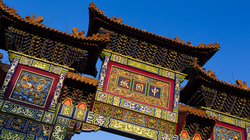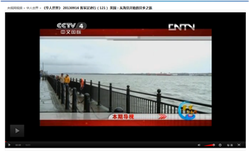|
|
Liverpool 1981, 24 mins long
The Birmingham based Here and Now television programme steps away from the Midlands with this in depth look at Liverpool's Chinatown. David Yip returns to his home town and is our guide for a tour that starts where the story of the community began: the Liverpool docks. From his melancholy visit to an abandoned boarding house to the birth of a new community centre for the city's young people Yip finds pride, tradition and vitality in a bustling enclave. Featuring: David Yip, Kenneth Lo |
Brief History of the Liverpool Chinese Community
Content below is part of a project entitled: ‘Beyond the Arch’ that promotes the profile of the Liverpool Chinese Community in 2007. The project was led by Hoy Yin Chinese Association; funded by Liverpool 08 Culture Company; supported by Edge Hill University; and many Chinese associations including Liverpool Chinatown Business Association. Photographic archive images were kindly supplied by individuals and the Liverpool Local History Library. The information was gathered by Ms. Donna Palmer, Ms. Kitty Butt and Mr. Alan Seatwo.
|
Liverpool has one of the oldest established Chinese communities in Europe. The trade links between China and Britain via the ports of Shanghai and Liverpool were instrumental in the establishment of a Chinese community within the city. The main trading goods were silk and cotton wool. The first vessel arrived in Liverpool direct from China in 1834. With the revision of the East India Company’s charter, the China trade was for the first time thrown open to private enterprise.
The first wave of Chinese immigrants arrived in 1866 with the establishment of the Blue Funnel Shipping Line a branch of the Holt Ocean Steamship Company, which ran a line of steamers directly from Liverpool to China. Chinese sailors who decided to stay in Liverpool and work from here settled in an area of the city that was close to the docks in Cleveland Square. Boarding houses were first opened by the Holt Shipping Company to accommodate their workers. It was here and in the surrounding streets that the first Chinese settlers started their own businesses supplying services to their countrymen. Liverpool City Council in 1906 commissioned a report to inquire into Chinese settlements; there were forty-nine laundries, thirteen boarding houses and seven shops kept by members of the Chinese community. |
When World War One started, there were up to 6,000 Chinese seamen in the British Merchant Navy and around 1,500 of them were based in Liverpool. After World War One the settlement spread slowly inland into the side streets such as Cornwallis Street and Dickenson Street, Kent Street and Greetham Street.
The demolition of the area known as Chinatown began as part of the 1930s council scheme to replace the old insanitary courts and warehouses with modern buildings. Understandably, this plan met with some resistance from members of the community. It was at this time due to the general economic depression and immigration restrictions that the Chinese community in Liverpool saw a reduction in its population size. The bombing of Liverpool in the 1940s destroyed much of the Pitt Street and Cleveland Square area and hastened the demolition of old Chinatown. After years of arduous warfare and lost ships and crews, the British Merchant Navy started recruiting sailors from its’ allies across the world and thus Liverpool was turned into a reserve pool for Chinese Merchant sailors, there were with up to 20,000 registered |
sailors at one point coming from China’s Shanghai, Ningbo, Shandong, Hong Kong and Singapore.
Thousands of the Chinese sailors lost their lives to the Atlantic during attacks from German submarines and as part of the British fleet, the Chinese sailors played an important role to Britain’s victory in the war. Members of the community were moved into the new tenements in Kent Street, Pitt Street and Upper Frederick Street. These times saw the community undergo great upheaval but the spirit of the people remained positive and the intervening years saw them establish many new projects such as the first edition of Chinese newspaper was printed and a China bank was opened in 1944; and Chinese Gospel Mission was set up in 1956. Members of the Chinese community no longer restricted their business interests to Chinatown and spread throughout the Merseyside area. Some shops and clubs reopened in Nelson Street and Great George Square. During the 1970s Nelson Street became the new hub of Chinatown and the business area extended into Berry Street, Duke Street and Upper Pitt Street. |
The long established Chinese organisations
|
Chinatown today is famous for its superb selection of Chinese restaurants but it is also home to many other successful businesses with wholesalers, travel agencies, legal and accountancy firms catering to the needs of the local community. Many Chinese cultural and community groups flourish here too. Here are some of the long established group details:
Che Gong Tong Chinese Association (UK) 10 Nelson Street, Liverpool L1 5DN Origin of the Association had a strong link with Dr Sun Yat-sen, often referred to as the "father of modern China", it supported the overthrow of the Qing Dynasty in 1911. The association has branches across the continents. The association in the UK was set up to unite overseas Chinese and provide support to each other. It is one of the oldest Chinese community organisations in Liverpool. The association organises their members to Everton and Anfiled cemetery twice a year to pay respect to Chinese ancestors who have no family in the UK. |
See Yep Chinese Association
22 Nelson Street, Liverpool L1 5DN See Yep is the name of four regions situated on the South-west of Kwantung province of China: Toi Shan, Hoi Ping, Tan Ping and Sun Wui. See Yep Chinese Assoication of England was set up in 1906 and their head office is based in Liverpool. The association has been supporting its members on social and welfare, business and cultural issues. It provides a venue for members to gather and entertain. The association helps members to prepare traditional Chinese funeral and arrange a resting-place at Everton or Anfield cemetery grounds so that Chinese could be allocated next to another. The association organises cultural festivals and events regularly throughout the year, such as Mid-Autumn Festival and day trips. |
Wah Sing Chinese Community Centre
149 Duke Street, Liverpool 1 4JR It was set up on 5th September 1965 aiming at new Chinese immigrants who came to England and work for rapidly increasing Chinese catering industry. The organisation provides a social meeting venue for those who experienced English language difficulties. They were mainly young men at that time. The centre was used for meeting, sharing information and seeking support from each other. On 23rd January 1983 the centre formed a constitution aiming to serve and unite fellow Chinese; working with local authority and organisations for the interests of Chinese Community. The Centre provides Chinese language classes for both Mandarin and Cantonese speaking Chinese children weekly. It also has groups for different interests, such as a Chinese Women Group and a Children’s Dance Group. The Centre celebrates traditional Chinese festivals and organises other cultural events. |
|
Liverpool Chinese Gospel Church
11 Gt George Square, Liverpool 1 5DY The Church was established in 1978. The membership is make-up of overseas students with Chinese decent, British born Chinese and local British residents. The Church offers its premise for pray, bible study and social and evangelistic functions. It has both Chinese and English Sunday services, Chinese language and culture class, student fellowship and workshops on topical subjects etc. It also provides Chinese and English funeral and wedding services. Hoy Yin Chinese Association 28 Nelson Street, Liverpool L1 5DN The Association was set up in 1995 to serve members from Hoy Yin region in China and the local Chinese Community. The Association bought the above mentioned premise as headquarter. The Association promotes Chinese culture and organises activities to celebrate traditional Chinese festivals. The Association aims to serve Chinese people regardless their religious and political beliefs. It also helps their members on issues such as social welfare, informing news about their hometown in China. |
The Liverpool Chinese Business Association (UK)
L/F, 94 Seel St, Liverpool L1 4BL The organisation is previously called Liverpool Chinatown Business Association. In 2007 the Association re-branded itself as Liverpool Chinese Business Association to reflect on their widen remit which work within and beyond Chinatown areas. It is a voluntary Chinese organisation serving businesses community in Chinatown and the Merseyside area. The organisation was set up in 1992 to co-ordinate efforts with other organisations to regenerate Chinatown area. One of the most successful projects that the Association involved is the construction of the Chinese Ceremony Archway. It offers advice for businesses and it provides a wide range of support services to promote community cohesions. The aim is to increase the profile of Chinatown and the competitiveness of Chinese businesses. |
The Pagoda of Hundred Harmony, Chinese Community Centre
Henry Street, Liverpool 1 5BU Prince and Princess of Wales marked the opening of the Centre in 1982. The Centre aims to articulate the needs of the Chinese Community across Merseyside to local authorities, government agencies and other service providers. It serves as a gateway to mainstream services which might otherwise not be easily accessible to Chinese people. It develops and provides a wide range of services to serve the Community’s social, economic, educational and cultural needs. The Centre organises both educational and cultural classes. It offers community welfare advisory services on matters such as health, housing, education and immigration etc. as well as translation and interpreting services. It is also the home of the largest Chinese Youth Orchestra in Europe. Through its sister charitable company Merseyside Chinese Community Development Association, the Centre facilitates other services such as Chinese Carers Network, Bi-lingual Chinese Community Newspaper and Chinese Elderly Luncheon Club. |
The Chinese Friendship Arch

This dazzling and spectacular Chinese Arch is the largest outside mainland China, standing approximately 13.5m high. It was shipped piece-by-piece in five 40-ft containers from Shanghai, Liverpool’s twin city, and erected here on Nelson Street in January 2000.
The Liverpool Chinese Community initiated the construction of the Arch in 1994. The Arch represents a successful partnership between the Liverpool Chinese Community, public and private sectors. The Arch was made if marble and wood; it was constructed by 10 craftsman specifically came from Shanghai and a local construction firm. The Arch has two hundred hand painted Dragons, one hundred and eighty-eight are male and twelve are female. It cooperated the principles of the Chinese art of Feng Shui in its design, decoration and positioning.
The Arch symbolises the eternal friendship between the two great seafaring cities. It is the focal point for Liverpool’s annual Chinese New Year festivities and the award-winning landmark has become one of Liverpool’s most loved attractions.
The Liverpool Chinese Community initiated the construction of the Arch in 1994. The Arch represents a successful partnership between the Liverpool Chinese Community, public and private sectors. The Arch was made if marble and wood; it was constructed by 10 craftsman specifically came from Shanghai and a local construction firm. The Arch has two hundred hand painted Dragons, one hundred and eighty-eight are male and twelve are female. It cooperated the principles of the Chinese art of Feng Shui in its design, decoration and positioning.
The Arch symbolises the eternal friendship between the two great seafaring cities. It is the focal point for Liverpool’s annual Chinese New Year festivities and the award-winning landmark has become one of Liverpool’s most loved attractions.
Other useful links

《华人世界》 20130916 客家足迹行(121) 英国:从海员开始的异乡之旅 Link to CCTV programme about Overesea Chinese history: Liverpool Chinese Seamen (programme in Chinese dialogue). LCBA assisted part of the production of a TV documentary about oversea Chinese by Central Chinese TV (CCTV) in 2012. |